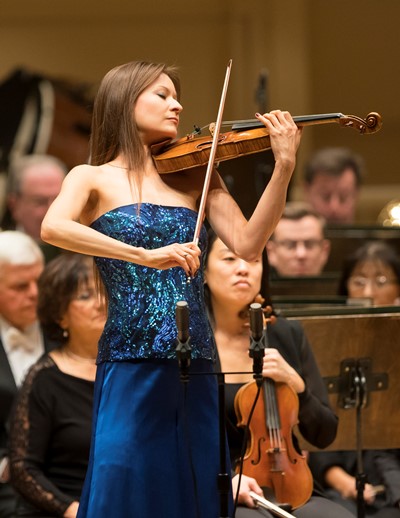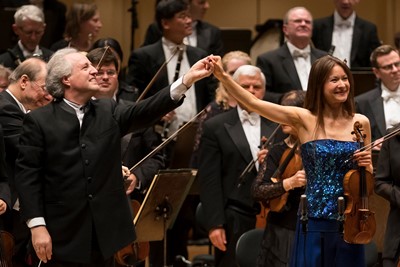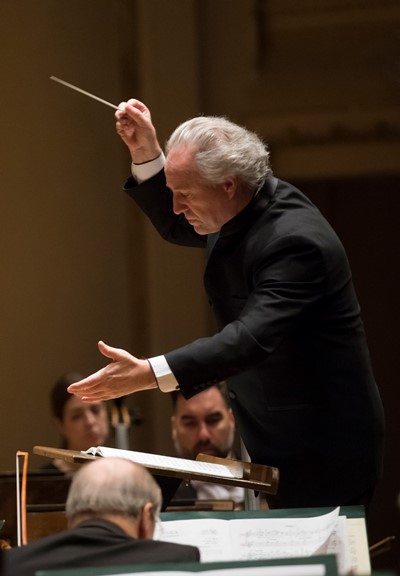CSO, two stellar guests in music from Vienna: Some of it in C major, and all of it great
Review: Chicago Symphony Orchestra conducted by Manfred Honeck; Arabella Steinbach, violin, at Orchestra Hall.
By Lawrence B. Johnson
When the Chicago Symphony Orchestra’s current season is well into the books, I will remember in detail the perfect convergence of music and moment that was the Nov. 11 concert with conductor Manfred Honeck and violinist Arabella Steinbacher.
Honeck, the 59-year-old, Austrian-born music director of the Pittsburgh Symphony Orchestra, was standing in for the indisposed Christoph von Dohnányi. But the program Honeck inherited from Dohnányi could scarcely have fit him better: two radiant masterpieces by composers of the Second Viennese School and Schubert’s Symphony No. 9 – the “Great C major,” whose prodigious breadth Schumann characterized as “heavenly,” and which on this occasion might well have sailed on and on into the empyrean.
 The first nine minutes of Honeck’s concert provided eloquent testimony to both the conductor’s craftsmanship and the CSO’s thoroughgoing virtuosity. That was the duration of Anton Webern’s 1935 orchestration of Bach’s six-voice ricercar (an early form of fugue) from “The Musical Offering.”
The first nine minutes of Honeck’s concert provided eloquent testimony to both the conductor’s craftsmanship and the CSO’s thoroughgoing virtuosity. That was the duration of Anton Webern’s 1935 orchestration of Bach’s six-voice ricercar (an early form of fugue) from “The Musical Offering.”
As a serial composer who liked to impose structural rigor on instrumental color as well as pitch sequence, Webern colorized Bach’s work in his wonted fashion, note by progressive note. Thus as the ricercar’s voices begin to overlay each other in counterpoint, Webern’s modern scoring evolves as a splendorous fountain of multicolored sound. The trick is to preserve Bach’s linear clarity within Webern’s textural richness, and this Honeck achieved with impeccable specificity. For its part, the Chicago Symphony as an aggregate made the whole thing sound as lustrous as it was transparent.
Alban Berg’s Violin Concerto, also written in 1935, is a full-on exercise in serial – or 12-tone – composition. It’s also a marvel of dramatic force, technical brilliance and lyric tenderness. Berg dedicated the concerto to the memory of the 17-year-old daughter of Alma (Mahler) Werfel. It would also prove to be his own requiem: He completed the work but did not live to hear it performed.
 In its finely hued orchestration and predominantly chamber-like intimacy, Berg’s concerto made a striking companion piece to Webern’s rethinking of Bach. Violin and orchestra are wholly integrated, and the German-born Steinbacher offered a performance that was at once virtuosic and personal and yet well attuned to the weight and impulse of the music around her. The 36-year-old violinist is much experienced in Berg’s concerto, and it told in her easy assurance.
In its finely hued orchestration and predominantly chamber-like intimacy, Berg’s concerto made a striking companion piece to Webern’s rethinking of Bach. Violin and orchestra are wholly integrated, and the German-born Steinbacher offered a performance that was at once virtuosic and personal and yet well attuned to the weight and impulse of the music around her. The 36-year-old violinist is much experienced in Berg’s concerto, and it told in her easy assurance.
Although the concerto is divided into two large movements, each of those is split again, so that the work unfolds in the novel order of slow-fast-fast-slow. That last, serene chapter takes the music to a place beyond this world through a series of variations on Bach’s chorale “Es ist genug” (It is enough). Steinbacher spun out her solo thread with consummate grace and luminosity, enfolded by an orchestral sound that bordered on angelic.
 While brisk tempos have come to be the satisfying norm in Beethoven’s symphonies, a sweeping away of Victorian pomposity to recapture the true spirit of the Classical era, one still tends to think of Schubert’s grand final symphony as just that – grand, majestic, epic, unhurried. Well, imagine the Great C major zipping along with the vitality and airiness of, say, Schubert’s lovely, lithe Symphony No. 5 in B-flat. Imagine that and you have Honeck’s astonishing gambol through the Big C (as distinguished from Schubert’s “little” C major, the Sixth Symphony).
While brisk tempos have come to be the satisfying norm in Beethoven’s symphonies, a sweeping away of Victorian pomposity to recapture the true spirit of the Classical era, one still tends to think of Schubert’s grand final symphony as just that – grand, majestic, epic, unhurried. Well, imagine the Great C major zipping along with the vitality and airiness of, say, Schubert’s lovely, lithe Symphony No. 5 in B-flat. Imagine that and you have Honeck’s astonishing gambol through the Big C (as distinguished from Schubert’s “little” C major, the Sixth Symphony).
From the outset, a proclamation for two French horns that usually suggests something of Homeric proportions is about to ensue, this was not your grandfather’s Great C major. Nor, for that matter, mine – the only way I’ve known the piece from the first time I heard an old Toscanini recording to the last time I heard the work in concert. This was fast, Schubert at a clip – and, very soon, infectiously vibrant, sunny and singing.
By the end, Honeck had sold me completely. Here was exuberant music-making that subtracted nothing from the magnificence of the Great C major. Honeck’s argument enjoyed crucial support from crisp, agile playing by the CSO strings that seemed exceptional even for that phenomenal choir. And the fleeting call-and-response between strings and winds was a heady delight throughout.
Even if there was no true slow movement (which I’m not sure Schubert intended anyway with the marking Andante con moto), Honeck’s nod to the music’s lyricism was indulgent and genuine at every turn. The finale was nothing short of rollicking – quick, propulsive, joyful. Music to send one wafting homeward without need of sidewalk or subway.


